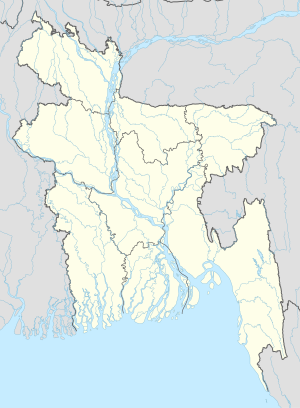Dulahazara Safari Park
| Dulahazara Safari Park ডুলাহাজারা সাফারি পার্ক |
||
|---|---|---|
| surface | 9 km | |
| opening | 1996 | |
| Animal species | 4000 | |
| Individuals | 165 | |
|
View of the Dulahazara Safari Park in late spring |
||
|
|
||
Coordinates: 21 ° 40 ′ 12 ″ N , 92 ° 5 ′ 24 ″ E
The Dulahazara Safari Park , ( Bengali ডুলাহাজারা সাফারি পার্ক Ḍulāhājārā Saphāri Pārk ), was built on a hilly landscape of around 9 km in area near Chakaria Upazila in the district of Cox's Bazar , Bangladesh , around 107 km from the port city of Chittagong , with the aim of being To create facilities for ecotourism , research and entertainment, and the conservation of wildlife in a natural environment. At least 4,000 animals from 165 species live in Dulahazara Safari Park.
history
The park was established in 1996. After the new government came to power in January 2007, joint forces rescued many of these new park residents during their trips to homes and facilities owned by suspects. Many individuals also donated some of the animals to the park during this time. Animals confiscated and donated recently sent to the park include 90 axis deer , 42 muntjacs , three sambars , an Australian crocodile , an estuarine crocodile , nine collar bears , four pythons , 17 peacocks , 19 Turkish pheasants and two emus .
Another animal source is the Bangladesh National Zoo . Their livestock had increased over the years due to their breeding, so he donated a number of lions and tigers to the Dulahazara Safari Park.
aims
The following goals were set for the safari park in 1998:
- Preservation and breeding of the extinct and endangered wild animal species in the park as an ex situ state.
- Assistance with in situ conservation of critically endangered wildlife across the country.
- Development of a rescue center and a veterinary hospital to support injured wild animals in the country.
- Development of the natural history museum to create awareness of nature conservation among the public.
- To bring large bodies of water for migratory birds under scientific guidance.
- Establishment of a bird hall for extinct, rare and endangered bird species.
- Establishment of a natural history museum for plants and animals that are endemic to the region .
Attractions
The park protects a large number of wild elephants that are native to the area. In the safari park there are domesticated elephants that are available for a ride. Other animal attractions include lions, bengal tigers , crocodiles, bears, axis deer, and many types of birds and primates .
Since the opening of the park, it has been attracting a large audience all year round - 6000 visitors daily in the high season (November to March) and 2000 visitors daily in the low season (April to October).
The park also houses an orchid collection and a museum.
gallery
Individual evidence
- ↑ a b c Nur Uddin Alamgir: Too many animals crammed at Dulahajra sanctuary leads to severe food crisis. In: The Daily Star . May 20, 2007, accessed May 23, 2019 .
- ↑ a b c Kausar Islam Ayon: Dhaka Zoo's excess crisis. In: The Daily Star . June 5, 2005, accessed May 23, 2019 .
- ↑ a b Dulhazra Safari Park (Bangabandhu Sheikh Mujib Safari Park) - Bangladesh. In: Shadmansadik. Retrieved May 23, 2019 .








